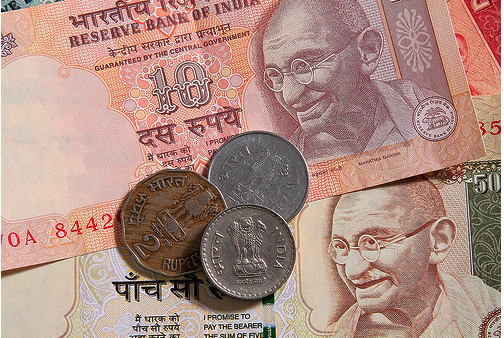Since March 2009, the rupee has been appreciating against the dollar – from 51.75 rupees per dollar in mid-March 2009 to 46.29 rupees per dollar at the end of January 2010, constituting a gain of almost 12 per cent. This appreciation has been triggered by the resumption of foreign capital inflows into the country after March 2009 (see Chart 1). So far, trends indicate that the country will end up with a current account deficit equal to about 2 per cent of GDP in 2009-10. In this context, we must ask whether the Indian rupee is now appropriately valued.
Chart 1: Rupee Appreciates as Foreign Exchange Reserves Build up (Source: Reserve Bank of India)
One way of judging whether a currency is in tune with fundamentals is by looking at the trends in its real effective exchange rate (REER).
The Reserve Bank of India computes the REER of the rupee by adjusting the rupee’s nominal effective exchange rate (NEER) for the relative price differential between India and a 36-currency basket, representing 47 major Indian trading partner countries (including 12 European Union countries). These countries accounted for about 89 per cent of India’s exports during the three-year period, 2002-05.
The NEER is a weighted average of nominal bilateral exchange rates of India against its major trading partner countries. To calculate relative prices, the Reserve Bank uses the wholesale price index (WPI) for India and consumer price indices for other countries. But this is incorrect. We have reconstructed an alternative REER for India using India’s consumer price index (CPI) instead of WPI. This makes a significant difference, as can be seen below in Chart 2.
Chart 2: Index of Nominal Effective Exchange Rate (NEER) and Real Effective Exchange Rate (REER) for the Rupee (36-Currency Export Weighted, Base: 2004-05=100) (Based on data from IFS, IMF and DGCI&S)
According to the above chart, in 2004-05, India’s current account was nearly in balance with a current account deficit of just 0.4 per cent of GDP. Thus, the rupee was in equilibrium that year. After peaking in 2007-08, the REER fell during the financial crisis period in 2008-09. But it has been moving up again since March 2009. By November 2009, it had broken the equilibrium value and had become overvalued by about 9 per cent. The REER computed by the Reserve Bank using India’s WPI is thus a gross underestimate and wrongly gives the impression of an undervaluation of the rupee.
The fact is that in recent months India has been losing export competitiveness. This is due partly to the nominal appreciation of the rupee and partly to high inflation. As exports have started to grow globally after a long period of sharp contraction, it is important that we maintain a competitive exchange rate. The Reserve Bank of India needs to consider this as it begins its tightening cycle.
This article first appeared here at ICRIER’S ‘Macro Perspectives and Updates’.
Matthew Joseph is a Senior Consultant and Karan Singh is a Consultant with the Indian Council for Research on International Economic Relations (ICRIER), New Delhi.


I’m even slower today and having difficulties in linking the two charts to form an idea what the authors are talking about.
Secondly, I am not sure the concept is always sound that the exchange rate is in equilibrium at the time when the current account is balanced.
While seemingly convincing, it would not be difficult for the existence of multi equilibrium (i.e. multi value) of the exchange rate if such a criterion is used. So there is at least a mechanism to reconcile such multi equilibrium.
This is because there are so many factors that affect current account balance (e.g. a severe incident can cause a change current account balance), not to mention differential growths in productivity between countries and changes in consumer preferences between countries.
A simple test, though not necessarily always sound by itself, would be how the current account balance changed in India since 2004-05? Do they correspond to the changes in the exchange rate, nominal or real?
I’m also slow with understanding the charts and implications drawn. From my limited knowledge, what matters under PPP ER theory is expected inflation rather than current inflation. While India’s CPI-inflation is at a decade high right now, that is primarily due to a drought and poor management of food stocks. Provided there is a normal monsoon, CPI inflation will moderate dramatically in 2011. The CA deficit would also shrink, as the food trade balance improves and international prices for certain food imports are likely to moderate (Sugar prices have been heavily skewed by Indian growing conditions over the past 2 years).
That being said, I really like pieces on this forum as they point out a bunch of interesting things I don’t know about. Thanks for posting and having the courage to make a call on currencies.